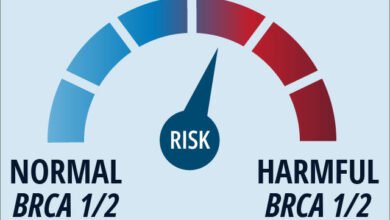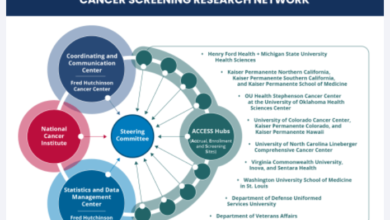Cancer Research UK – Science blog

Generations of scientists have dedicated their lives to understanding and treating cancer, often funded by us at Cancer Research UK, a charity that has spent more than a century driving progress for patients
Written by David Cox for Guardian Labs
Mick Bulbrook, left, who pioneered the use of the breast cancer drug tamoxifen, at the Imperial Cancer Research Fund labs in the 70s.
In October 2001, the cell biologist and geneticist Sir Paul Nurse received a phone call from Stockholm telling him that he had won the Nobel prize in physiology or medicine. He didn’t quite believe it was true until he saw his name appear on the official Nobel website, confirming he had indeed been awarded medicine’s highest honour.
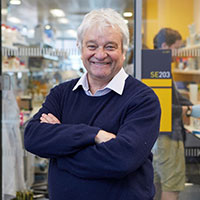
Sir Paul Nurse
It was the culmination of a remarkable journey for a scientist who had built his reputation through studying a form of yeast used for brewing beer in east Africa, known as Schizosaccharomyces pombe.
Nurse was fascinated by the cell cycle, and the processes that control the continuous growth and division of the cells that make up living organisms. The comparatively simple yeast cells provided him with an excellent model to search for genes which govern how this happens.
By the mid 1980s, his work had attracted the attention of the Imperial Cancer Research Fund (ICRF), a charity that merged with the Cancer Research Campaign in 2002 to form Cancer Research UK. It funded him to find out whether there were equivalent genes in human cells.
“At the time, everyone thought this was a bit bonkers,” says Iain Foulkes, our executive director of research and innovation. “How on earth could you tell something about the human condition by studying yeast? But it gave us a real insight into how cells divide.”
Thanks to research, more people like Marianne – who was diagnosed with breast cancer – are getting good news.
In 1987, Nurse and colleagues published a seminal paper in the journal Nature reporting the discovery of a gene which became known as cyclin-dependent kinase (CDK). We now know that CDK genes, and the proteins they produce, are critical to all cell growth and division. When this process malfunctions, cells proliferate out of control, which is what happens in cancer.
This was a landmark moment because, at the time, scientists were still attempting to work out exactly what controlled cell division, and how and why tumours formed. “There was a lot of focus on oncogenes, genes which induce cancer, and also growth factors which induce cells to grow and divide,” Nurse recalls.
“From then onwards scientists managed to start identifying the molecules that were central to cancer, because before that it was really completely unknown what was happening.”
Nurse’s discovery of CDK genes led to a firm basis for understanding how cells control their reproduction, which is critical for thinking about cancer. It also, eventually, led to a whole new class of cancer medicines called CDK inhibitors, which are gaining importance in the treatment of advanced breast cancer.
“It shows you how long it can take for a discovery to turn into something practical,” he says. “But it also shows that sometimes this kind of basic research can have huge implications. To make a major impact, you need to discover new things.”
Pioneering work
The discovery of CDK genes is just one of many remarkable stories across our 120-year history. Our story began in September 1901 when a wealthy businessman called Thomas Rudd authored a letter in the St James’s Gazette proposing a fund for a “cancer klinik” to study all aspects of the disease with a view to finding a cure.
At the time, the prognosis for anyone diagnosed with the disease was grim indeed. In 1802 the physician Thomas Denman had written “little is at present known of cancer, but as an incurable disease”, and one hundred years on, not much had changed.
Through Rudd’s connections in London, £33,460 (around £4m today) was raised from philanthropists to support research into the disease. In 1904, the fledgling charity gained the support of Edward VII, and the ICRF was born.
Over the next few decades, it would help pioneer some of the first ever cancer treatments, beginning with experimental radiation therapy for women with cervical cancer during the 1920s. But one of the most well-known modern cancer medicines originated from an unlikely source.
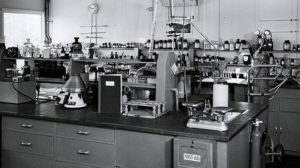
An Imperial Cancer Research Fund lab in the 60s
Doctors in the US studying the impact of mustard gas attacks on the immune systems of soldiers during the first world war came to realise that if the gas could wipe out ordinary white blood cells, it could also destroy cancerous tissue.
In August 1942, a patient in the US, known only as JD, was prescribed nitrogen mustard to treat his advanced lymphoma. While he only survived for three more months, the drug did briefly halt his symptoms, eventually paving the way for a new class of drugs known as chemotherapies.
By this time, a second national cancer charity had been set up in the UK – the British Empire Cancer Campaign (BECC), founded in 1923. It would later become the Cancer Research Campaign. In the late 40s, researchers at an institute funded by BECC – the Chester Beatty Laboratories in London (now the Institute for Cancer Research) – unpicked exactly how these chemotherapies worked, opening the door to newer, more effective, less toxic cancer drugs.
Today the success of modern chemotherapies such as cisplatin and carboplatin – which work in a similar manner to nitrogen mustard, and which Cancer Research UK helped develop – has increased long-term survival, including boosting testicular cancer survival to 95%.
All in all, Foulkes says that as of 2021, there are 11 cancer drugs on the market that directly owe their existence to Cancer Research UK, and many more to which our research has contributed. These range from abiraterone, a hormone-based treatment for prostate cancer, to temozolomide for brain tumours.
For many patients, these drugs have proven to be life-saving interventions. In 2012, Alfred Samuels was told he could have just months to live after being diagnosed with advanced prostate cancer, but his prognosis changed remarkably after he began receiving abiraterone as part of a Cancer Research UK-funded clinical trial called STAMPEDE.

Alfred Samuels with his wife Grace
“I’m still here, and I would never have thought that possible,” says Samuels. “I really thought the curtains had closed on me. So far, the treatment has been working and my cancer is being managed well. While I’ll be on the treatment for the foreseeable future, it’s given me the chance to live life.”
But our success has not just been in the realm of new treatments. Our work has also identified many of the key genes and processes involved in cancer development, including the p53 “genome guardian” protein, and the BRCA2 “breast cancer” gene. One of our biggest legacies has been in cancer prevention through the funding of studies that have shown the dangers of various factors, including smoking and asbestos exposure.
During the first half of the 20th century the number of people dying from lung cancer increased hugely. In 1950, a UK study published by the epidemiologists Richard Doll and Austin Bradford Hill was one of the first to point the finger at smoking. The pair went on to prove their suspicions were right – thanks in part to our support.
Foulkes says: “We funded long-term population research through which we were able to clearly demonstrate the link between tobacco and cancer. We also funded research into the ingredients within tobacco smoke, which were creating DNA damage and could lead to mutations and tumours, and went on to successfully campaign for action on tobacco, such as the ban on smoking in public places.”
Looking to the future
Now, as we look forward to the coming decade and beyond, the landscape of cancer care is one of increasing optimism. Our goal is to improve survival of those diagnosed with cancer to three in four by 2034, by funding research into fields such as personalised therapies and early detection programmes.
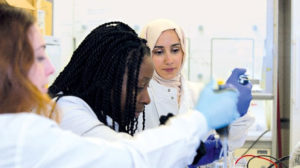
CRUK-funded researchers in the lab, among them Dr Mariam Jamal-Hanjani, back.
Michelle Mitchell, our chief executive officer, is particularly excited about the outcomes of TRACERx, a landmark multimillion-pound research project which is studying the variation between, and changes in, tumour samples collected from hundreds of lung cancer patients. The aim is to be able to understand the principles underpinning cancer evolution – how patient’s tumours change over time – and so open the door to a new wave of personalised therapies and monitoring technologies.
We’re also focusing heavily on research into detecting cancer. “I think the prospect of early detection, and improvements in early diagnosis, could bring huge improvements in cancer survival, because we know that people’s survival improves considerably the earlier they are diagnosed,” says Mitchell. “So I think this is a great opportunity for us to really shift the dial on early detection and diagnosis, which would be a major contribution to improving cancer survival in the UK and worldwide.”
This article was originally published on theguardian.com as part of the Cancer Research UK and Guardian Labs Cancer revolutionaries campaign.
Source link
#Cancer #Research #Science #blog

